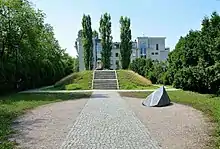Miła 18
Ulica Miła 18 (or 18 Pleasant Street in English) was the headquarters "bunker" (actually a hidden shelter) of the Jewish Combat Organization (ŻOB), a Jewish resistance group in the Warsaw Ghetto in Poland during World War II.
| Kopiec Anielewicza | |
 General view of Miła 18 memorial | |
| Location | Warsaw, Poland |
|---|---|
| Designer | Unknown (commemorative stone), Hanna Szmalenberg and Marek Moderau (obelisk) |
| Material | Granite |
| Completion date | 1946, 2006 |
History

The bunker at Miła 18 was constructed by a group of underworld smugglers in 1943. The ŻOB fighters arrived there after their own hideout, at 29 Miła Street, had been discovered.[1] The smugglers who had built it were helping the ŻOB as guides.
On 8 May 1943, three weeks after the start of the Warsaw Ghetto Uprising, when the bunker was found out by the Nazis, there were around 300 people inside. The smugglers surrendered, but the ŻOB command, including Mordechaj Anielewicz, the leader of the uprising, stood firm. The Nazis threw tear gas into the shelter to force the occupants out. Anielewicz, his girlfriend Mira Fuchrer and many of his staff committed mass suicide by ingesting poison rather than surrender, though a few fighters who did neither managed to get out of a rear exit, and later fled from the ghetto through the canals to the "Aryan side" at Prosta Street on May 10.[2]
Remembrance

In July 1945 suriviors of the Jewish Underground (Among them Simcha Rotem) visited the ruins above the Command bunker.[3] The bodies of Jewish fighters were not exhumed after 1945 and the place gained a status of war memorial. In 1946, the monument known as "Anielewicz Mound", made of the rubble of Miła houses, was erected. A commemorative stone with the inscription in Polish and Yiddish was placed on top of the mound.
In 2006, a new obelisk designed by Hanna Szmalenberg and Marek Moderau was added to the memorial. The inscription in Polish, English and Yiddish reads: "Grave of the fighters of the Warsaw Ghetto Uprising built from the rubble of Miła Street, one of the liveliest streets of pre-war Jewish Warsaw. These ruins of the bunker at 18 Miła Street are the place of rest of the commanders and fighters of the Jewish Combat Organization, as well as some civilians. Among them lies Mordechaj Anielewicz, the Commander in Chief. On May 8, 1943, surrounded by the Nazis after three weeks of struggle, many perished or took their own lives, refusing to perish at the hands of their enemies. There were several hundred bunkers built in the Ghetto. Found and destroyed by the Nazis, they became graves. They could not save those who sought refuge inside them, yet they remain everlasting symbols of the Warsaw Jews’ will to live. The bunker at Miła Street was the largest in the ghetto. It is the place of rest of over one hundred fighters, only some of whom are known by name. Here they rest, buried as they fell, to remind us that the whole earth is their grave." The names of 51 Jewish fighters whose identities have been established by historians are engraved on the front of the obelisk.
Although it is often claimed that Miła 18 was the last shelter in the Ghetto to fall, this was not the case (according to Jürgen Stroop, his men took 30 "bunkers" on 12 May alone). It should be also noted that the current street numbering in Miła Street does not correspond to the wartime numbering: the memorial is nowadays at the intersection of Miła and Dubois streets while the current Miła 18 is an apartment block around 700 metres to the west.
Jewish fighters who died at Miła 18


- Chaim Akerman
- Małka Alterman
- Mordechaj Anielewicz
- Nate Bartmeser
- Heniek Bartowicz
- Franka Berman
- Tosia Berman
- Icchak Blaustein
- Melach Błones
- Berl Braude
- Icchak Chadasz
- Nesia Cukier
- Icchak Dembiński
- Józef Fass
- Efraim Fondamiński
- Towa Frenkel
- Emus Frojnd
- Mira Fuchrer
- Wolf Gold
- Miriam Hajnsdorf
- Aron Halzband
- Rut Hejman
- Mira Izbicka
- Salke Kamień
- Ziuta Klejnman
- Jaffa Lewender
- Lolek (first name only)
- Sewek Nulman
- Abraham Orwacz
- Rywka Pasamonik
- Majloch Perelman
- Aron Rajzband
- Lutek Rotblat
- Miriam Rotblat
- Jardena Rozenberg
- Salka (first name only)
- Jerzy Sarnak
- Szmuel Sobol
- Basia Sylman
- Szyja Szpancer
- Moniek Sztengel
- Szulamit Szuszkowska
- Mojsze Waksfeld
- Olek Wartowicz
- Icchak Wichter
- Arie Wilner
- Zeew Wortman
- Hirsz Wroński
- Rachelka Zylberberg
- Moszek Zylbertszajn
- Sara Żagiel
References
| Wikimedia Commons has media related to Miła 18 Memorial. |
- J.Leociak, Spojrzenia na warszawskie getto. Ulica Miła, Dom Spotkań z Historią, Warszawa 2011, p. 26.
- C.Lubetkin, Zagłada i powstanie, Książka i Wiedza, Warszawa 1999.
- Sztetl org Mila 18 Bunker site photograph